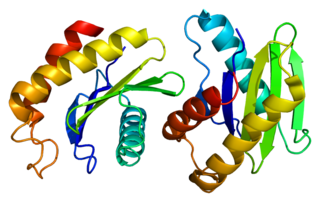
Activating transcription factor 6, also known as ATF6, is a protein that, in humans, is encoded by the ATF6 gene and is involved in the unfolded protein response.

Protein transport protein Sec61 subunit beta is a protein that in humans is encoded by the SEC61B gene.

Protein SEC13 homolog is a protein that in humans is encoded by the SEC13 gene.

Conserved oligomeric Golgi complex subunit 7 is a protein that in humans is encoded by the COG7 gene.

Protein transport protein Sec61 subunit alpha isoform 1 is a protein that in humans is encoded by the SEC61A1 gene.

Vesicle-trafficking protein SEC22b is a protein that in humans is encoded by the SEC22B gene.

BET1 homolog is a protein that in humans is encoded by the BET1 gene.

Conserved oligomeric Golgi complex subunit 4 is a protein that in humans is encoded by the COG4 gene.

RAD50-interacting protein 1 is a protein that in humans is encoded by the RINT1 gene.

Conserved oligomeric Golgi complex subunit 8 is a protein that in humans is encoded by the COG8 gene.

Conserved oligomeric Golgi complex subunit 5 is a protein that in humans is encoded by the COG5 gene.

Endoplasmic reticulum-Golgi intermediate compartment protein 2 (ERGIC2) is a gene located on human chromosome 12p11. It encodes a protein of 377 amino acid residues. ERGIC2 protein is also known as PTX1, CDA14 or Erv41.

Conserved oligomeric Golgi complex subunit 1 is a protein that in humans is encoded by the COG1 gene.

Conserved oligomeric Golgi complex subunit 2 is a protein that in humans is encoded by the COG2 gene. Multiprotein complexes are key determinants of Golgi apparatus structure and its capacity for intracellular transport and glycoprotein modification. Several complexes have been identified, including the Golgi transport complex (GTC), the LDLC complex, which is involved in glycosylation reactions, and the SEC34 complex, which is involved in vesicular transport. These 3 complexes are identical and have been termed the conserved oligomeric Golgi (COG) complex, which includes COG2.

Vesicle-trafficking protein SEC22a is a protein that in humans is encoded by the SEC22A gene.

Endoplasmic reticulum-Golgi intermediate compartment protein 3 is a protein that in humans is encoded by the ERGIC3 gene. It has been reported to be regulated by micro RNAs and may be important in a cancer.

Protein transport protein Sec24D is a protein that in humans is encoded by the SEC24D gene.

Protein transport protein Sec24B is a protein that in humans is encoded by the SEC24B gene.

Chloride channel CLIC-like 1 also known as CLCC1 is a human gene.
SEC31 is a protein which in yeast promotes the formation of COPII transport vesicles from the Endoplasmic Reticulum (ER). The coat has two main functions, the physical deformation of the endoplasmic reticulum membrane into vesicles and the selection of cargo molecules.


















